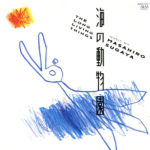
Masahiro Sugaya has always been an interesting composer. Based in Tokyo, it’s been his music that’s soundtracked dance theater group Pappa TARAHUMARA’s most known works. Masahiro’s music draws from a mix of minimal, ambient, world, and Japanese traditional styles. So, no one album or song can perfectly distill how varied (in mood and sound) each project will be. Somehow, though, if I’m asked to pick a good start to search further, I’d draw most to his work on 1988’s The Long Living Things (Zoo Of The Sea).

Born in Tokyo, in 1959, Masahiro Sugaya had always drawn from the city a harbor for all things Japan would cultivate in this home base. His gifted piano playing and in-depth computer-based compositional talents afforded Masahiro the ability to make a living as in-house arranger for the Pappa TARAHUMARA theater company. As in-house composer, early on, his focus wasn’t on making music for static listening. Making music for dance was a lot different than making music for dancing.
On pieces like Alejo and The Landscape of the Heat, or “Pocket of Fever”, as it’s known on discogs, Masahiro had to work together with dance director Hiroshi Koike to make sure the movements made sense with Hiroshi’s choreography and the company’s own multi-media stagecraft full of installations and experimental scenery. Their goal was create a stage show that could embody a “cosmic” feeling where noble spirituality can be felt and heard emanating from the stage. With roots in Japanese Butoh dance, Hiroshi Koike’s earliest works immediately brought to mind the works of Merce Cunningham and John Cage. Masahiro had to meet that level of progression equally.
Masahiro did his role by taking the placid ambient music of the Roedelius or Harold Budd type and update it through all sorts of digital samplers and synths, to create a hune where the dance crew could cycle in and out of peaceful synthetic ambiance or uptempo electro-acoustic minimalist music. Trying to bridge the gap between European next-wave experimentation and new-form Japanese spatial music, Masahiro’s own work hit a graceful note that allowed it function as “theater” music but also as distinct BGM one can listen after the fact.
Meant to be listened to as entire pieces Masahiro’s two first dance scores were self-released and sold at Pappa TARAHUMARA’s residency at the Kichijoji Baus Theater. In the end, both of those pieces remained elusive and out of reach for most who’d never journeyed to see those early performances.
In 1988, ALM Records gave Masahiro his first chance to release on CD the entirety of a new score he created for the Pappa TARAHUMARA production called “Zoo of the Sea”. In full definition, Masahiro finally had the clarity of sound to actually display his own talent as a composer. What you here instantly is how much livelier his take on New Age ambient music is. Songs like “カメレオン・ガーデン (Chameleon Garden)” and “空にとけるサーカス (Circus Melts In Check)” have these little blips and blops that appear generative, vibrant, never reacting quite as you expect. Little melodies come in giving you counterpoints that approximate really experimental, innocent techno music — if such a genre exists.

If you’ve heard Hiroshi Yoshimura’s Soundscape 1: Surround, you should feel a degree of familiarity with the spirit of Masahiro Sugaya’s The Long Living Things (Zoo Of The Sea). The more spectral, minimal beats like “海の砂粒 (Grain Of Sand Of The Sea)” and “青 (Blue)” paint sparse, impressionistic notation you can imagine scoring very personal solos. Deeply yearning and spiritual songs like “世界の果てまで (To The World’s End)” twist treated electric piano, classical guitar, and watery synthesized plonks like percolating ruminative tools to really chew on, for something than just a mere moment. In this sound Masahiro gets to Pappa TARAHUMARA’s transcendent quest to integrate itself to the rest of the world’s vanguard, for a higher purpose (erased of needless borders). An obvious highlight, such a song imagines its sound as an ark-like collection of the best bits from so many things Masahiro is obviously moved by.
The album ends as if under the influence of Bill Evans: woke, transformed, troubled, yet still willing itself to find something meaningful to move forward with. It’s something, hopefully, we can all empathize with.
FIND/DOWNLOAD (LINK REMOVED DUE TO REISSUE)
